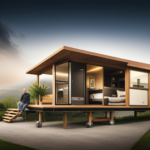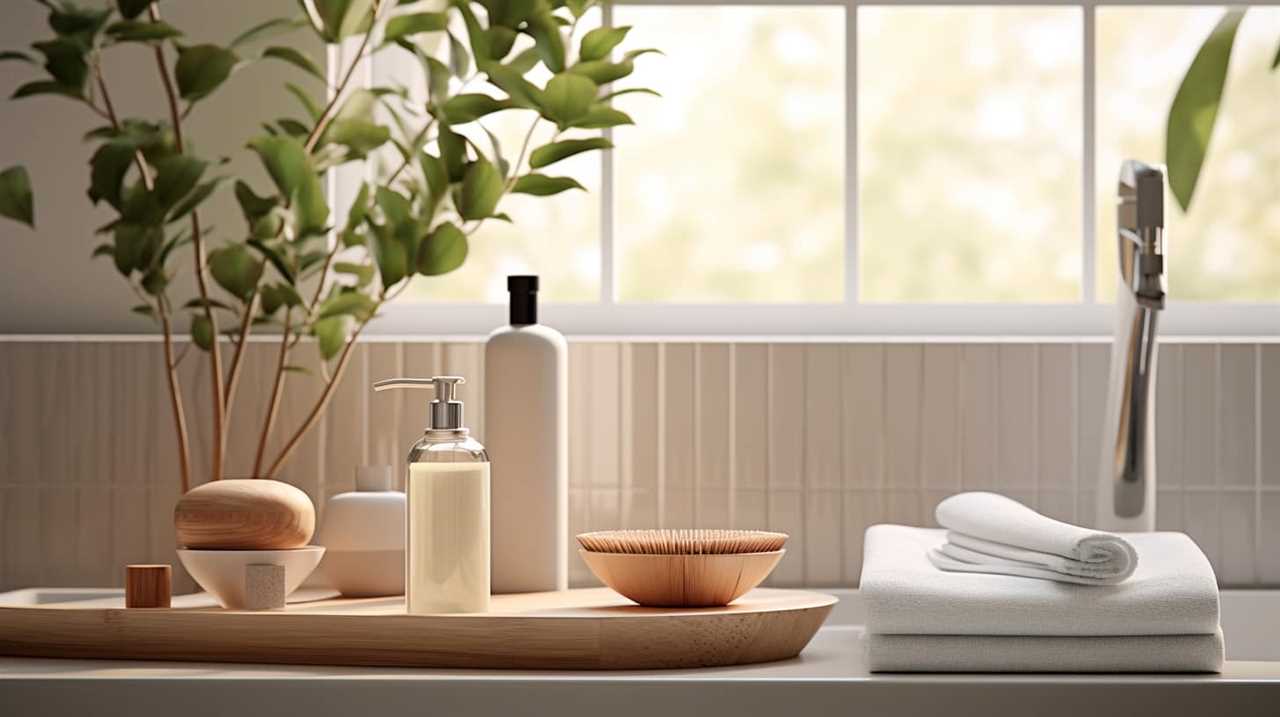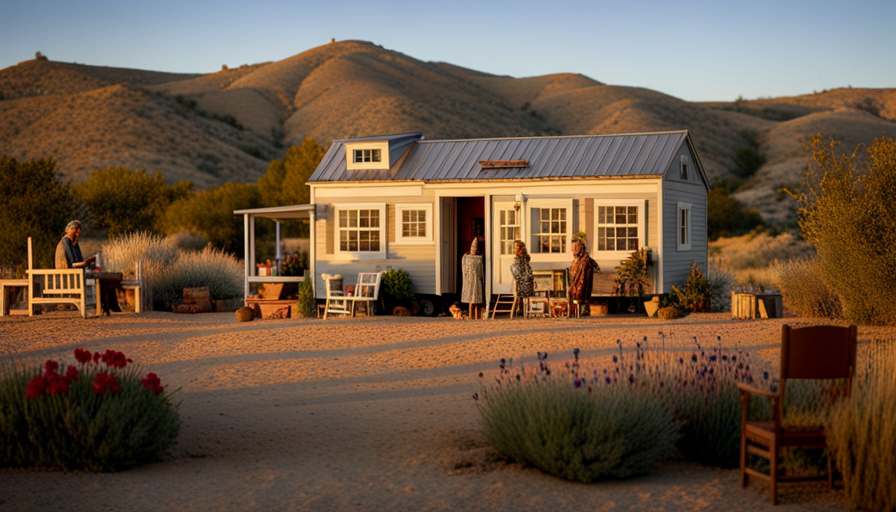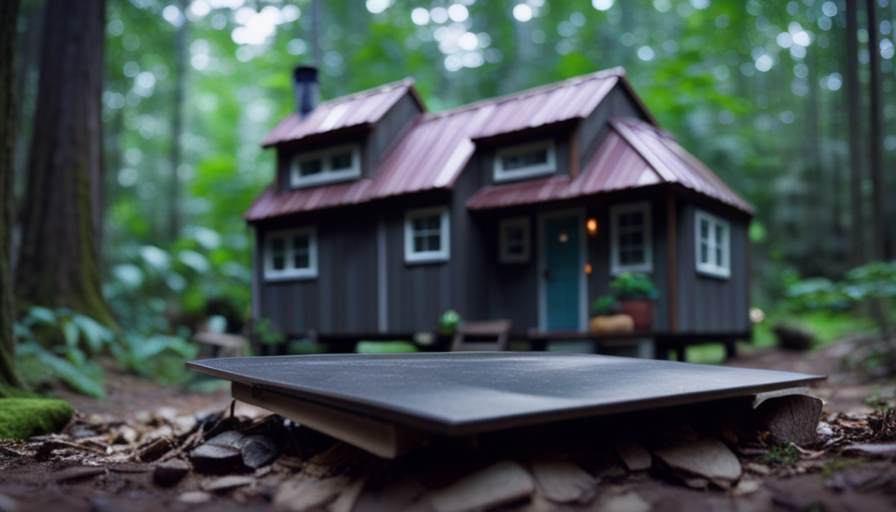Are you tired of being stressed out by mess and unnecessary items? We’ve got your back.
In our article, we’ll reveal the 7 keys to designing comfortable minimalist living spaces.
By embracing simplicity, focusing on functionality, and incorporating natural elements, you can create a haven of tranquility and balance.
With our expert tips, you’ll learn how to optimize natural light, declutter your possessions, and strike the perfect balance between open spaces and cozy areas.

Get ready to transform your home into a place of serenity and style.
Key Takeaways
- Embrace simplicity and minimalism by decluttering and removing unnecessary items.
- Focus on functionality and space optimization by choosing multifunctional furniture and utilizing vertical storage solutions.
- Use neutral color palettes and texture to create a calming and cohesive atmosphere.
- Declutter and minimize possessions by sorting belongings and utilizing smart storage solutions.
Embrace Simplicity
Let’s start by focusing on the importance of simplifying and streamlining our living spaces. Embracing simplicity is a key element in creating a minimalist decor that promotes a sense of calm and tranquility.
By decluttering our homes and removing unnecessary items, we can create a space that feels open and spacious. Minimalist design emphasizes clean lines, neutral colors, and a lack of excessive ornamentation, allowing the beauty of simplicity to shine through.
Focus on Functionality
As we continue to design comfortable minimalist living spaces, it’s important to focus on functionality. In small spaces, it becomes crucial to make every inch count and ensure that each item serves a purpose.
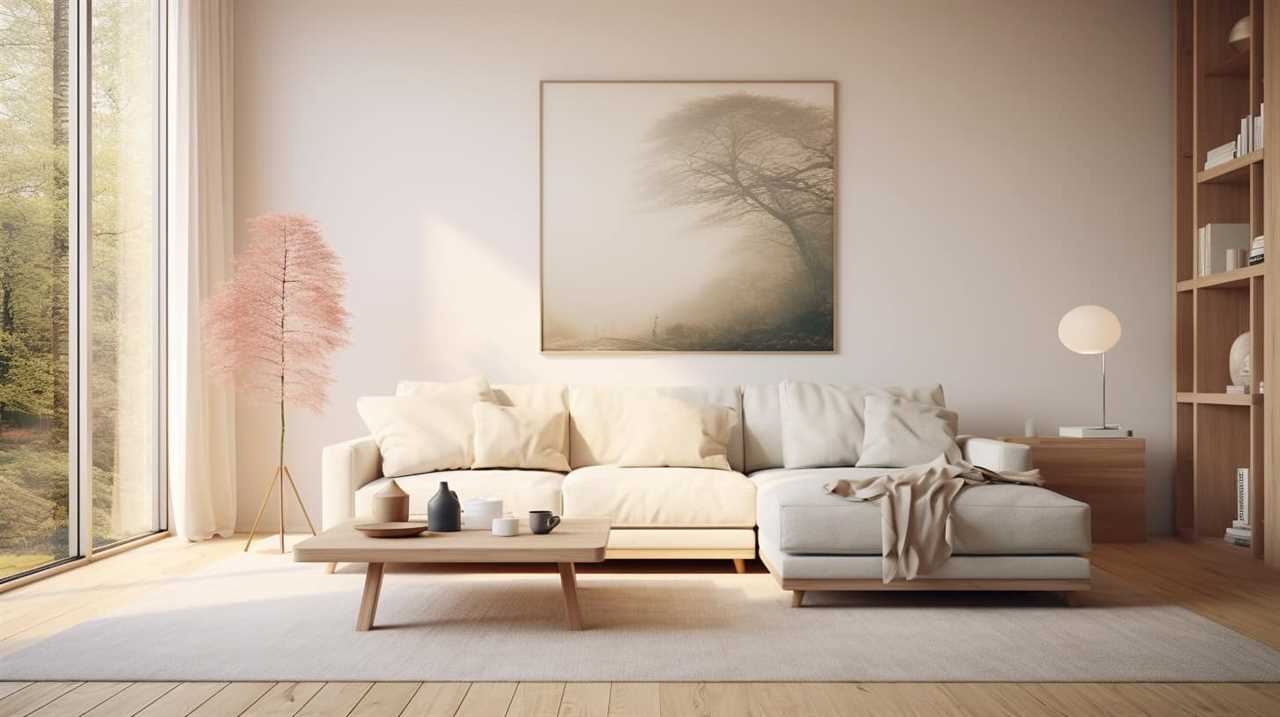
Here are three key aspects to consider when it comes to functionality in small spaces:
-
Multifunctional furniture: Opt for furniture pieces that serve multiple purposes, such as a sofa that can be transformed into a bed or a coffee table with hidden storage compartments. This allows you to maximize the functionality of each item while minimizing clutter.
-
Space optimization: Make use of vertical space by installing shelves or wall-mounted storage units. This helps to free up floor space and keep the area organized. Additionally, consider using furniture with built-in storage solutions to further maximize space.
-
Traffic flow: Plan the layout of your space in a way that allows for easy movement and access to different areas. Avoid placing furniture or objects that obstruct the natural flow of traffic, creating a more functional and convenient living environment.
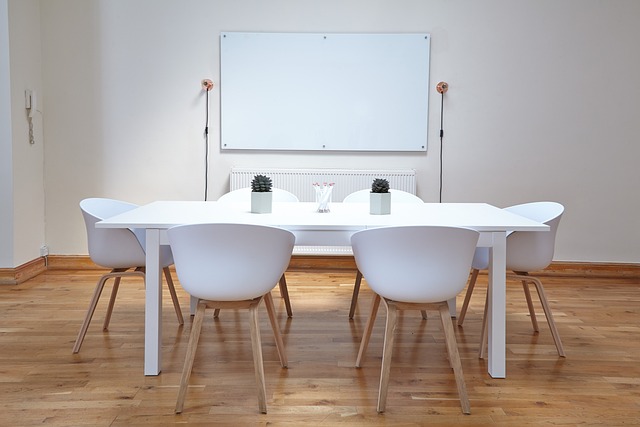
Use Neutral Color Palettes
We can create a calming and cohesive atmosphere by using neutral color palettes in our minimalist living spaces. Neutrals, such as shades of white, beige, and gray, have several benefits to offer. Firstly, they provide a sense of tranquility and relaxation, making our living spaces feel more inviting. Secondly, neutrals act as a canvas, allowing us to easily incorporate pops of color through accessories or furniture. Lastly, neutral colors are timeless and versatile, ensuring that our spaces remain stylish for years to come. To add visual interest and depth to our minimalist living spaces, we can use texture. Incorporating different textures, such as soft fabrics, natural materials, and rough finishes, helps to create a tactile experience and adds warmth to the space. By combining neutral color palettes with texture, we can design comfortable and visually appealing minimalist living spaces.
| Benefits of neutrals | Using texture |
|---|---|
| 1. Calming atmosphere | 1. Tactile experience |
| 2. Versatile and timeless | 2. Added warmth |
| 3. Easy to incorporate pops of color | 3. Visual interest and depth |
Declutter and Minimize Possessions
To create a truly minimalist living space, we must ruthlessly declutter and minimize our possessions. This step is crucial in achieving a serene and clutter-free environment. Here are some organizing techniques to help you maximize storage and create a minimalist haven:
-
Embrace the KonMari method: Sort through your belongings and keep only the items that truly spark joy. This will help you let go of unnecessary possessions and create a more intentional space.
-
Utilize smart storage solutions: Invest in furniture with hidden compartments or built-in storage to keep your belongings out of sight. This will help maintain a clean and clutter-free appearance.

-
Adopt a one-in, one-out rule: For every new item you bring into your home, let go of something else. This will prevent accumulation and ensure that your space remains minimal and uncluttered.
By decluttering and minimizing our possessions, we can create a harmonious and calming living space.
Now, let’s explore how incorporating natural elements can enhance the minimalist aesthetic.
Incorporate Natural Elements
As we strive to create comfortable minimalist living spaces, incorporating natural elements can greatly enhance the overall atmosphere and well-being of the space.
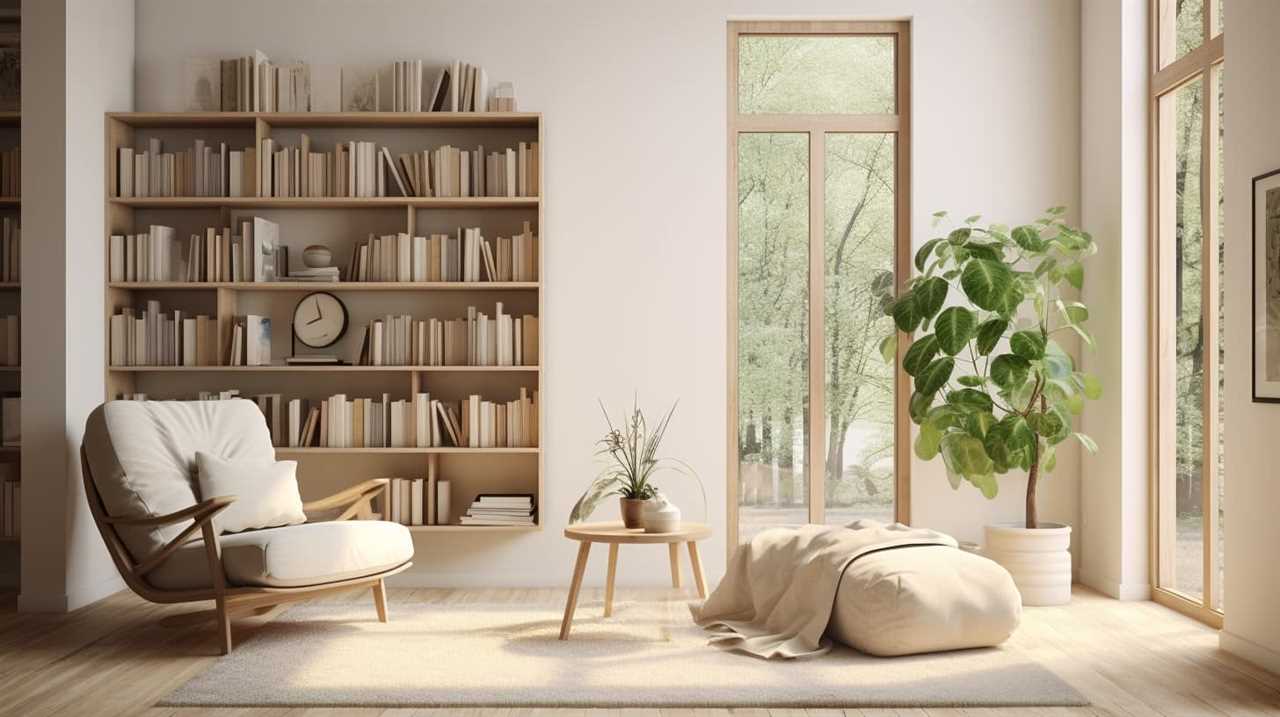
Natural elements have numerous benefits, such as reducing stress, increasing productivity, and improving air quality.
In order to incorporate these elements creatively, we can consider adding plants, using natural materials like wood and stone, and maximizing natural light through large windows or skylights.
Benefits of Natural Elements
Using natural elements in our minimalist living spaces can greatly enhance the overall comfort and ambiance of the environment. Incorporating biophilic design and benefiting from its numerous advantages, we can create a harmonious and soothing atmosphere in our homes. Here are three reasons why incorporating natural elements is beneficial:
-
Improved well-being: Surrounding ourselves with natural elements, such as plants and natural light, can reduce stress levels and promote a sense of well-being.

-
Increased connection to nature: By incorporating natural materials like wood and stone, we can bring the beauty of the outdoors inside, fostering a deeper connection to nature.
-
Enhanced air quality: Natural elements, particularly indoor plants, can act as natural air purifiers, filtering out toxins and improving the overall air quality in our living spaces.
Creative Ways to Incorporate
With a combination of thoughtfully chosen materials and strategic placement, we can effortlessly incorporate natural elements into our minimalist living spaces, creating a harmonious and inviting atmosphere.
One creative way to do this is by using innovative furniture that incorporates natural elements. For example, you can choose a coffee table made from reclaimed wood or a shelving unit made from bamboo. These pieces not only add a touch of nature to your space but also serve a practical purpose.
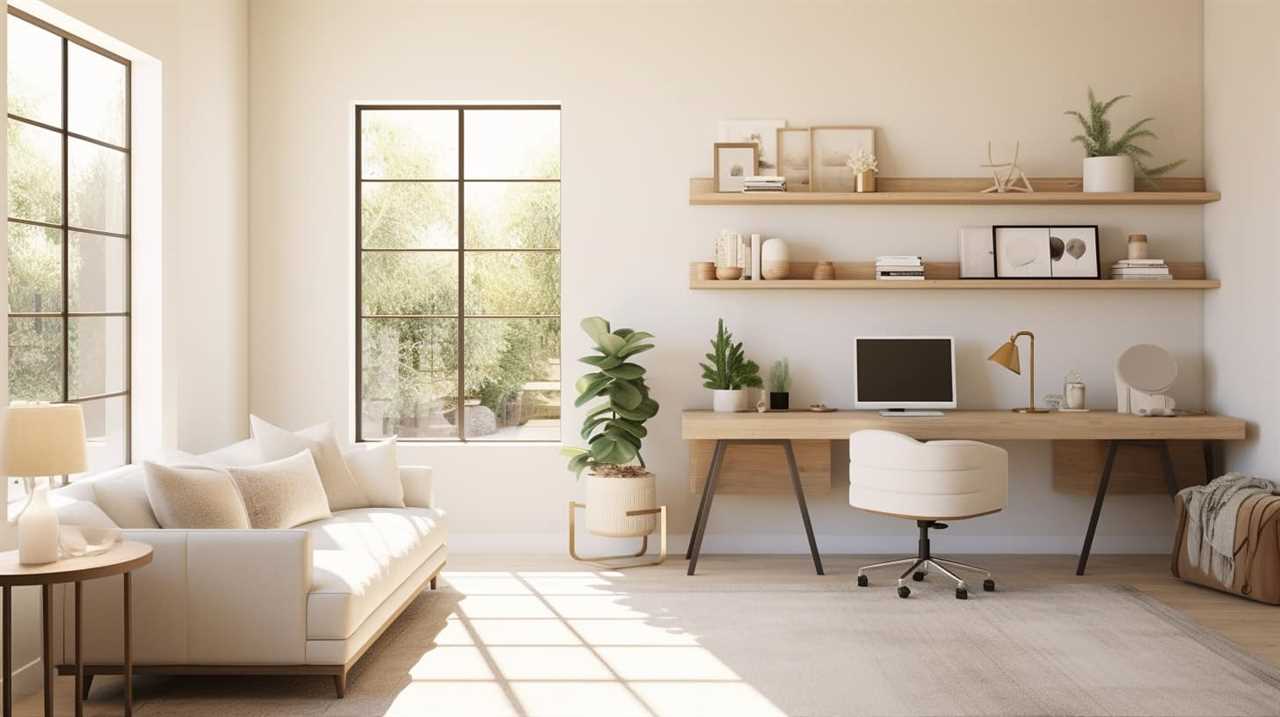
Another way to incorporate natural elements is through creative storage solutions. You can use woven baskets or wooden crates to store items, adding texture and warmth to your minimalist space.
Additionally, you can hang plants from the ceiling or place them on floating shelves, bringing life and freshness to your living area.
Optimize Natural Light
When it comes to designing comfortable minimalist living spaces, optimizing natural light is essential. We can achieve this by carefully considering window placement and size, ensuring that they allow ample sunlight to enter the space.
Additionally, incorporating reflective surfaces and materials can help to bounce light around the room, creating a brighter and more open atmosphere.

Lastly, utilizing skylights efficiently can bring in even more natural light, transforming the space into a welcoming sanctuary.
Window Placement and Size
As we consider the design of comfortable minimalist living spaces, one key aspect to focus on is the placement and size of windows in order to optimize natural light. Windows play a crucial role in creating a bright and airy atmosphere, while also providing a connection to the outdoors.
Here are three important considerations for window placement and size:
-
Strategic placement: Positioning windows in areas where natural light is abundant, such as south-facing walls, allows for maximum sunlight throughout the day. Placing windows near areas where people spend the most time, like seating areas or workspaces, ensures they can benefit from the natural light.
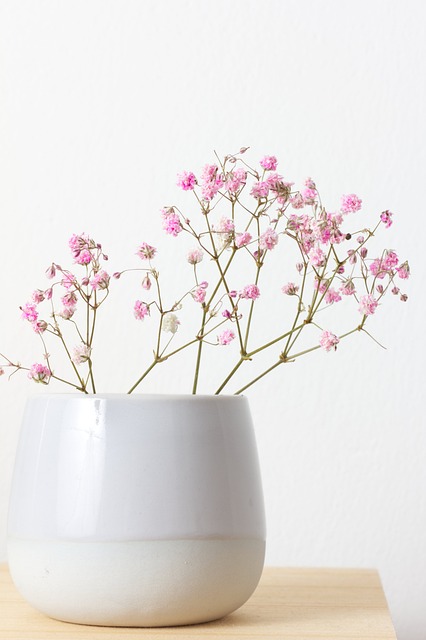
-
Size matters: Opt for larger windows to allow more light to enter the space. Consider floor-to-ceiling windows or even skylights to flood the room with natural light. However, it’s essential to balance the window size with privacy needs and the overall aesthetics of the space.
-
Consider the view: Window placement should also take into account the view outside. Frame picturesque landscapes, lush greenery, or even urban cityscapes to create a visually pleasing experience that inspires and relaxes.
Reflective Surfaces and Materials
Two materials that can help optimize natural light in minimalist living spaces are mirrors and polished surfaces. Mirrors are a versatile choice as they not only reflect light, but also create an illusion of a larger space. Placing a large mirror opposite a window can maximize the amount of natural light that enters the room, making it feel brighter and more open. Polished surfaces, such as polished concrete or glossy tiles, also have reflective properties that bounce light around the room. These surfaces not only enhance the natural light, but also add a sleek and modern touch to the minimalist decor. By strategically incorporating reflective surfaces and materials, you can create a bright and airy atmosphere in your minimalist living space.
| Reflective Surfaces and Materials | Benefits | Examples |
|---|---|---|
| Mirrors | Reflect light, create illusion of larger space | Large wall mirrors, mirrored furniture |
| Polished surfaces | Bounce light around, sleek and modern touch | Polished concrete, glossy tiles |
Utilizing Skylights Efficiently
We can effectively optimize natural light in our minimalist living spaces by utilizing skylights. Skylights not only bring in an abundance of natural light but also add a touch of elegance and openness to the room.

To make the most of skylights, consider the following:
-
Efficient skylight designs: Choose skylights that are energy-efficient and have high insulation values to prevent heat loss during winter and heat gain during summer.
-
Skylight placement optimization: Place skylights strategically to maximize the amount of natural light entering the space. Consider the orientation of the room and the path of the sun throughout the day.
-
Utilize skylight accessories: Install blinds or shades to control the amount of sunlight entering the room and to provide privacy when needed.

Balance Open Spaces With Cozy Areas
Creating a seamless transition between open spaces and cozy areas is essential for designing comfortable minimalist living spaces. It is important to strike a balance between the airy, spacious feel of minimalism and the warmth and comfort of cozy elements. One way to achieve this is by incorporating cozy seating options throughout the space. Plush sofas and armchairs provide a soft and inviting place to relax and unwind. Additionally, warm lighting plays a crucial role in creating a cozy atmosphere. Soft, warm-colored lights can be strategically placed to highlight certain areas and create a sense of intimacy. By combining cozy seating and warm lighting, you can effectively balance the open and cozy areas in your minimalist living space, providing a comfortable and inviting environment for you and your guests.
| Cozy Seating Options | Warm Lighting |
|---|---|
| Plush sofas | Soft, warm-colored lights |
| Armchairs | Strategically placed lighting |
| Cushioned stools | Accent lighting |
| Cozy floor cushions | Dimmable lights |
Frequently Asked Questions
How Can I Incorporate Natural Elements Into My Minimalist Living Space?
Incorporating greenery and using sustainable materials are key to creating a comfortable minimalist living space. We can enhance our space by bringing in natural elements that provide a sense of tranquility and promote a healthier environment.
What Are Some Tips for Optimizing Natural Light in a Minimalist Living Space?
Maximizing natural light in a minimalist living space is crucial. To achieve this, selecting the right window treatments is essential. We’ll guide you on how to optimize natural light and choose the perfect window coverings.
How Can I Strike a Balance Between Open Spaces and Cozy Areas in My Minimalist Living Space?
To strike a balance between open spaces and cozy areas in our minimalist living space, we focus on creating a calming ambiance and achieving a functional layout. It’s all about finding harmony in simplicity and comfort.
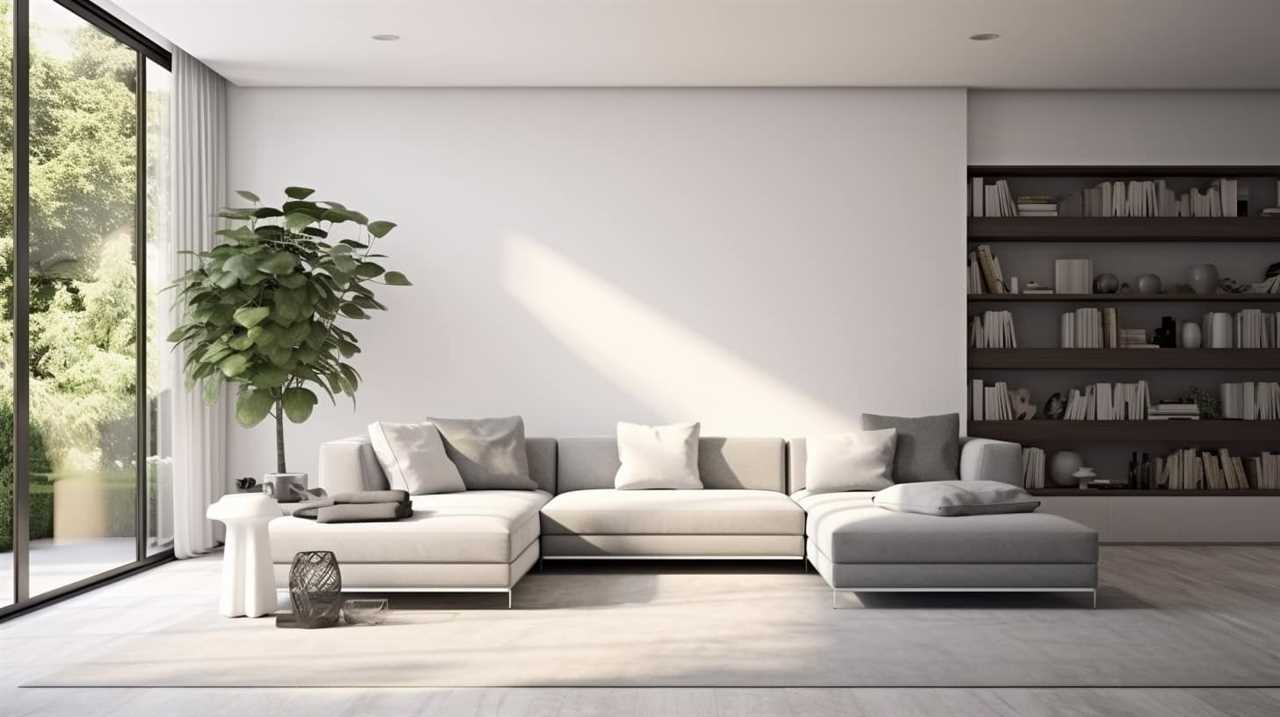
What Are Some Strategies for Decluttering and Minimizing Possessions in a Minimalist Living Space?
When it comes to decluttering and minimizing possessions in a minimalist living space, we’ve found that implementing effective strategies for decluttering and organizing minimal belongings can make a big difference in creating a clean and serene environment.
Can You Provide Some Examples of How to Use Neutral Color Palettes Effectively in a Minimalist Living Space?
Using textures in a minimalist living space adds depth and warmth. We love incorporating statement pieces into a neutral color palette for a stylish and serene environment that feels both inviting and calming.
Conclusion
Incorporating the keys to designing comfortable minimalist living spaces can transform your home into a sanctuary of peace and tranquility. By embracing simplicity, focusing on functionality, and using neutral color palettes, you can create a space that exudes calmness and serenity.
Decluttering and incorporating natural elements will further enhance the peaceful atmosphere, while optimizing natural light and balancing open spaces with cozy areas add a touch of warmth and comfort.

Get ready to indulge in the minimalist lifestyle and experience the blissful simplicity it brings.
I’m Theodore, and I love tiny houses. In fact, I’m the author of Tiny House 43, a book about tiny houses that are also tree houses. I think they’re magical places where imaginations can run wild and adventures are just waiting to happen.
While tree houses are often associated with childhood, they can be the perfect adult retreat. They offer a cozy space to relax and unwind, surrounded by nature. And since they’re typically built on stilts or raised platforms, they offer stunning views that traditional homes simply can’t match.
If you’re looking for a unique and romantic getaway, a tree house tiny house might just be the perfect option.







